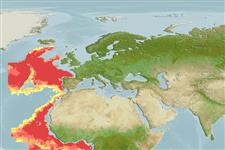Actinopterygii (ray-finned fishes) >
Lophiiformes (Anglerfishes) >
Oneirodidae (Dreamers)
Etymology: Dolopichthys: Greek, 'dolops' or 'dolopos' = ambusher + Greek, 'ichthys' = fish (meaning "a fish that attacks by surprise") (Ref. 86949). More on author: Regan, Trewavas.
Environment / Climate / Range
Ecology
Marine; bathypelagic; depth range 690 - 1353 m (Ref. 86949). Deep-water, preferred ?
Tropical to temperate parts of all oceans.
Size / Weight / Age
Maturity: Lm ? range ? - ? cm
Max length : 8.9 cm (female)
Short description
Morphology | Morphometrics
Dorsal
soft rays
(total): 7-8;
Anal
soft rays: 6. Characterized by having escal bulb with two short distally bifurcating papillae on anterior midline, each devoid of pigment and lying very close together; absence of bilaterally placed papillae on dorsal surface of escal bulb; compressed posterior appendage less than length of escal bulb in specimens 33 mm and smaller, more than three times length of escal bulb in 89 mm specimen; unpigmented swollen basal part of posterior appendage in specimens 33mm and smaller, lightly pigmented in 89 mm specimen; absence of connecting membrane between anterior and posterior filaments of posterior escal appendage in specimens 19.5 mm and larger (Ref. 86949).
Also mesopelagic (Ref. 10524).
Life cycle and mating behavior
Maturity | Reproduction | Spawning | Eggs | Fecundity | Larvae
Bertelsen, E., 1990. Oneirodidae. p. 498-507. In J.C. Quero, J.C. Hureau, C. Karrer, A. Post, and L. Saldanha (eds.) Check-list of the fishes of the eastern tropical Atlantic (CLOFETA). JNICT, Lisbon; SEI, Paris; and UNESCO, Paris. Vol. 1. (Ref. 10524)
IUCN Red List Status (Ref. 115185)
CITES (Ref. 94142)
Not Evaluated
Threat to humans
Harmless
Human uses
More information
Common namesSynonymsMetabolismPredatorsEcotoxicologyReproductionMaturitySpawningFecundityEggsEgg development
Age/SizeGrowthLength-weightLength-lengthLength-frequenciesMorphometricsMorphologyLarvaeLarval dynamicsRecruitmentAbundance
ReferencesAquacultureAquaculture profileStrainsGeneticsAllele frequenciesHeritabilityDiseasesProcessingMass conversion
Tools
Special reports
Download XML
Internet sources
